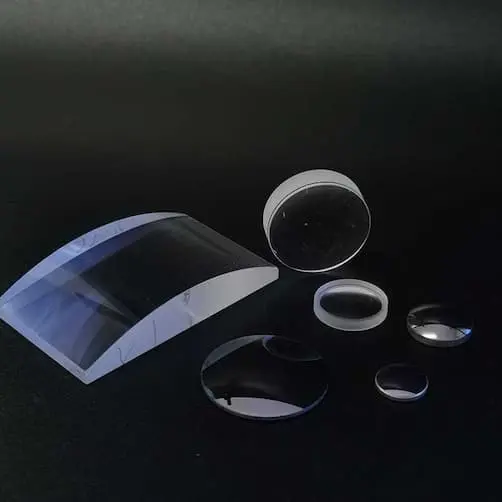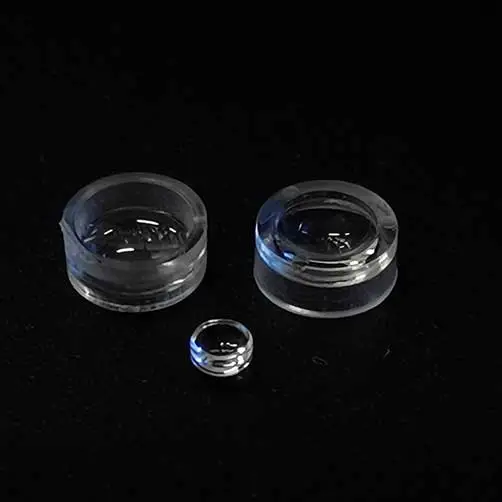Polarizing beamsplitter cube can achieve the customer's transmit and reflect request.
Different Ratio
High Surface Quality
High Damage Threshold
High Accuracy
Material | BK7 Grade A Optical Glass |
Dimension (h) Tolerance | ±0.1 mm |
Dimension (A) Tolerance | ±0.2 mm |
Clear Aperture | >80% |
Surface Quality | 60-40 Scratch And Dig |
90° Deviation | Refer to The Table |
Flatness: | λ/4 @632.8 nm |
Reflectivity | R>95% Per Face @630-680 nm |
Protective Bevel | 0.25 mm x 45° |
Material | Optical Glass, Fused Silica, Sapphire. |
Dimension | 1-250 mm |
Dimension Tolerance | +0/-0.1 mm |
Surface Flatness | λ/10@632.8 nm |
Surface Quality | 10-5 |
Angular Accuracy | 5 Second |
Coating | Uncoated, AR, HR, Beamsplitter, etc. |
A x h (mm) | 1 min. Deviation | 30 sec. Deviation | 10 sec. Deviation | 5sec. Deviation |
Part No. | Part No. | Part No. | Part No. | |
7 x 6 | FBP101 | FBP201 | FBP301 | FBP401 |
8 x 8 | FBP102 | FBP202 | FBP302 | FBP402 |
10 x 10 | FBP103 | FBP203 | FBP303 | FBP403 |
Polarizing beam splitter cube is an optical device that separates or combines two orthogonal polarization states in a beam of light. It works on the principle of polarization, specifically using the Brewster angle effect and total internal reflection.
The splitter cube is made of two prism halves, which are optically cemented together at their hypotenuse faces with a thin layer of dielectric coating applied on one of the halves. The dielectric coating layer partially reflects the p-polarization light and transmits the s-polarization light at a specific angle, thereby splitting the incident beam into two orthogonal polarizations.
When light passes through the splitter cube in one orientation and reflects off surfaces within the cube, it is polarized in the opposite direction and separated from the incoming polarization. The splitter cube can also be used in reverse to combine two orthogonal polarizations into a single beam.
The polarizing beam splitter cube is commonly used in applications such as imaging, polarization analysis, and interferometry, among others.
TC Optics is a leading optical prism manufacturer offering high-quality polarizing beamsplitter cube. Our products ensure quality assurance, making them the perfect choice for your optical needs. Trust TC Optics for your polarizing cube requirements.
Corner cube and polarizing beam splitter cube are two optical devices used in various applications. Though they can appear similar in construction, they have different operating principles and uses. The following are the significant differences between these two devices:
Operating Principle: The corner prism is based on the principle of total internal reflection, where light is reflected back to the source from three orthogonal surfaces. In contrast, the polarizing beam splitter cube operates based on the separation of orthogonal polarization states using a dielectric coating layer.
Function: A Corner cube reflects light back to the source in a direction parallel to the incident beam, ensuring that the beam is reflected back to the sender regardless of its orientation. A polarizing beam splitter cube is used to split or combine polarized light into two orthogonal polarization states.
Material: Corner cubes are typically made of prisms, glass or plastic materials, whereas polarizing beam splitter cubes are made of optically cemented prisms with dielectric coating.
Applications: Corner cubes are commonly used in reflectors, surveying, and retroreflection applications, while polarizing beam splitter cubes are used for polarization analysis, interferometry, and imaging applications.
In conclusion, although corner cube and polarizing beam splitter cube may appear similar in construction, they operate differently and have varying applications.
If you would like to build your own precision optical products or request a quote, please click one of the two buttons below. Otherwise, please fill out the form below with any questions or concerns.

Address
No. 946,Chaoyue street,High-tech zone,Changchun city,Jilin
Call Us
+86-431-84563660


